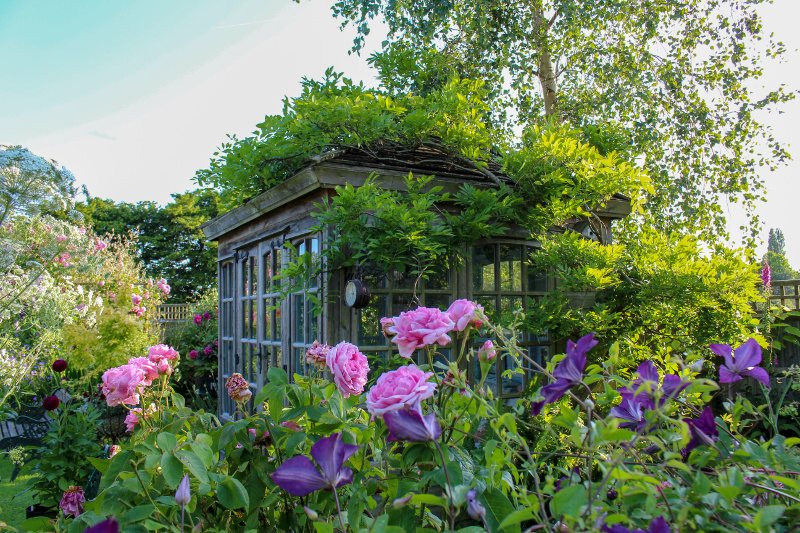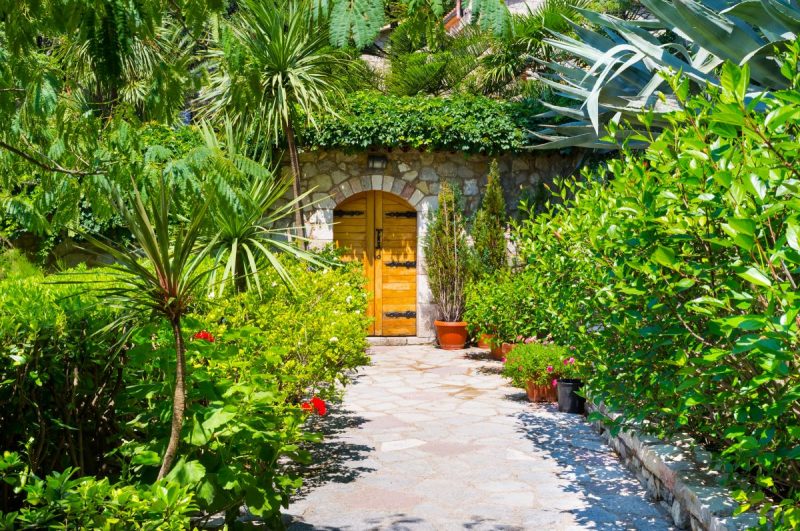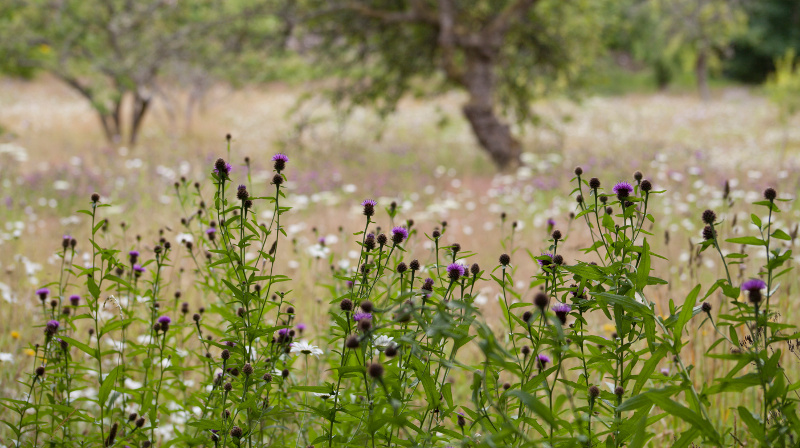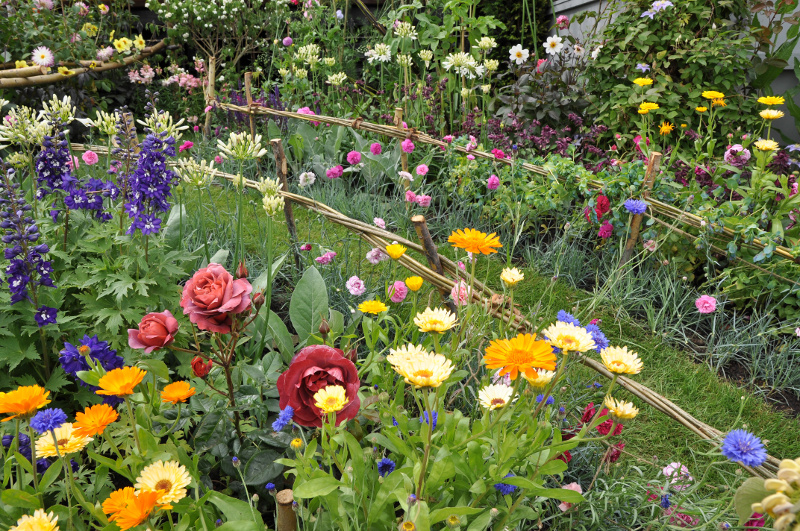With the big garden shows kicking off next month with Chelsea, it’s the time when we gaze into our crystal ball to spot the trends we see emerging for garden design and planting.
The overarching trend towards ‘environmentally healthy gardens’ seem strong for 2023. As does the understanding of how important immersing ourselves in nature and green space is for our mental and physical wellbeing. Both of which are inspiring designers into creativity that’s increasingly more sensitive to our needs and the wider worlds.
So, here’s what we see as being big this year to provide inspiration for your own garden projects.
Go green to the core
As we’ve all seen a shift in our climate, we in turn have had to alter our gardening practices to accommodate hot dry summers and warmer wetter winters.
Sustainable and eco-friendly gardening is an answer to this problem, and we predict that we’ll start to see more gardens with these elements designed into their core.
No longer will these just be a style trend, but a necessity to ensure our gardens don’t contribute to the problem and can help to mitigate against future damage.
Using less water, harvesting rainwater, increasing plant diversity, choosing ethically and locally sourced materials, going peat free, caring for our soil and gardening organically are all ways that we can start to do our bit from the ground up.
Drought resilient planting
With this shift towards a warmer climate, we’re seeing a rise in popularity towards a couple of garden styles that work in harmony with the weather as they use more resilient, drought tolerant planting.
A Mediterranean style garden not only brings a taste of the holidays to your own backdoor but is full of plants that cope with drier soils in the summer. In 2023 gardens inspired by the Med are bringing the holiday vibe to life using limited colour palettes of calming blue and white tones or warm terracotta, with features such as statues and archways to add dimension to the space. Planting is being kept simple and predominantly green with pops of colour here and there for interest.
Gravel gardens are also set to feature in more gardens this year. Specifically designed for poor soil in very dry conditions, these could be the answer to the sun-soaked patch of your garden where most plants struggle to grow. Instead by embracing these difficult conditions and using drought tolerant plants you can have a thriving showpiece.
Drought tolerant plants suited to gravel gardens are ones with grey-green leaves that reflect the heat. For example herbs like sage and rosemary. Shrubs like lavender, hebe and artemisia. Perennials like erigeron, euphoria, gaura, verbena, echinops, heuchera and salvias. And ornamental grasses like pennisetum, panicum and stipa.
Letting lawns go wild
Last years record summer temperatures and accompanying hosepipe ban had many of us reconsidering whether our lawns remain a good option in the garden.
Not only does a green expanse that’s weed free, neatly trimmed, well-watered and regularly fed take a lot of care, but the chemicals, fertilisers and fuel used to keep it pristine also have a wider environmental impact.
Instead, gardens in 2023 are embracing a more relaxed approach to lawns as we allow parts to turn to meadow and grow wild for the benefit of pollinators. Tapestry lawns that intertwine wildflowers and native plants in patterns through the grass are also high on designers lists.
Weeds previously considered the enemy of the garden are also finding a new lease of life as drought tolerant varieties such a fescue grass and micro-clovers help lawns to stay green without watering in dry conditions.
Gardens for all seasons
Over the past couple of years, we’ve seen a big shift towards getting the most from our gardens right through the year. We’ve grown to value them as a space that we can enjoy all year round, made possible by incorporating a few simple changes.
Zoning gardens into specific living spaces through adding outdoor kitchens and outdoor furniture has helped us create highly functional areas for entertaining.
Adding firepits and outdoor lighting creates warmth and ambience allowing us to comfortably use our gardens into the evening hours and for longer through the year.
Successional planting provides gorgeous views and visual interest no matter what the season. Careful selection of plants and trees that give good value throughout the year will ensure there’s always something new to enjoy.
Think of adding the spring blossom of fruit trees and the cheerful colours of narcissi and daffodils. Borders full of the sights and scents of summer flowers and shrubs like dahlias, roses, salvias and hydrangeas. The bright reds and yellows of autumn leaves and berries on trees such as the amelanchier. The beauty of winter frost on seed heads and grasses against a background of eye-catching barks and stems found on birches and cornus.
The quintessential cottage garden
Talking of planting, something we’re going to be seeing a lot of this year is a return to the English cottage garden. This wonderfully romantic informal planting style harks back to a time when gardens were as functional as they were beautiful.
Cottage gardens were traditionally viewed as a working garden that needed to provide sustenance as much as to look aesthetically pleasing. Comprising borders and beds packed with decorative favourites like foxgloves, roses, sweet peas, peonies and lupins, these gardens would also have vegetable plot, a herb garden, fruit trees, mini meadow and possibly even chickens or bees.
Bringing all these elements into gardens in the 21st century creates a self-sustaining environment that’s rich in biodiversity and insect life, and productive all year round. Flowers can be cut for the displays in the house, and their seeds dried and stored for propagating next year. Vegetables and fruit grown and eaten fresh or preserved for winter months. Herbs used for fresh meals or dried for longer use. While garden waste can be recycled and turned into rich compost for mulching and improving your soil.
This really is one garden that works as hard for you as it does for the wider environment.





